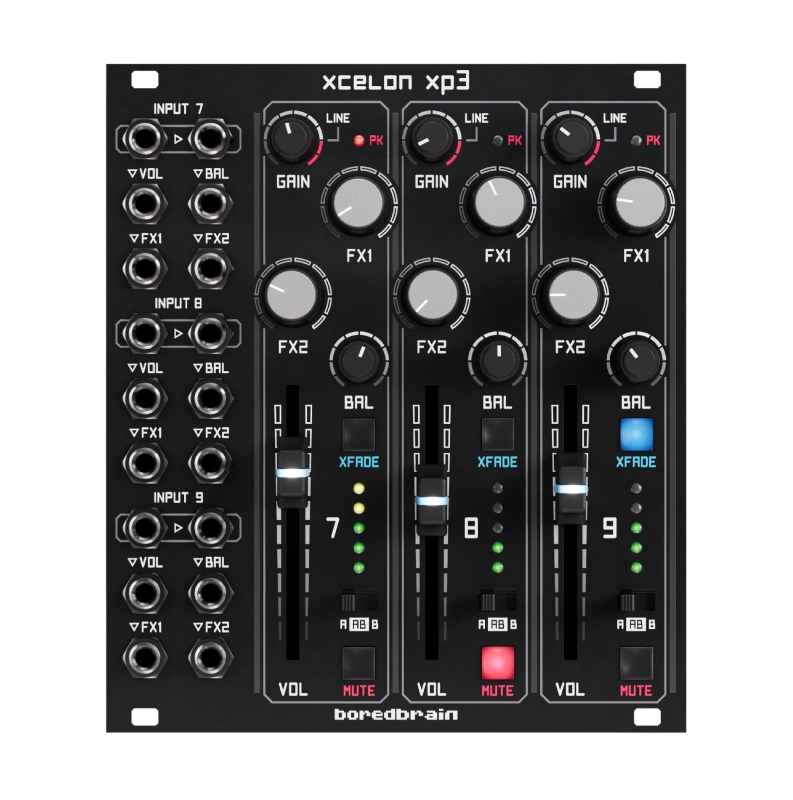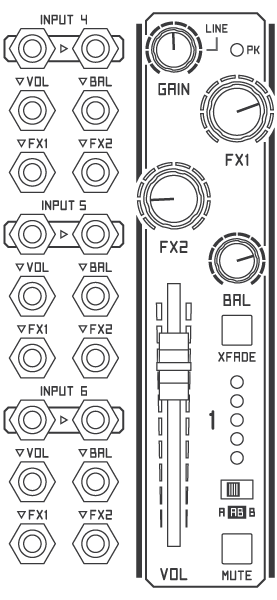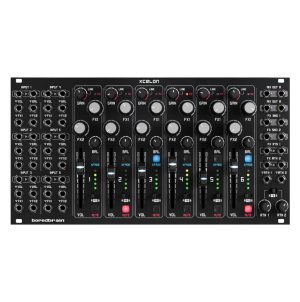Boredbrain xcelon
TRUE STEREO VOLTAGE-CONTROLLED MIXER
A modular mixing powerhouse
Xcelon is an all-analog six-channel stereo audio mixer for eurorack modular systems. With an interface designed for immediate hands-on control and visual feedback, plus extensive CV and expandability, the module is a powerful mixing tool for both performance and production.
- Six stereo/dual-mono channels with low-noise analog circuitry
- Two stereo FX sends and two dedicated FX returns
- Two stereo output mix busses selectable per-channel
- Variable input gain for both modular and line-level sources
- Long-travel volume faders with CV responsive LED indicators
- Balance controls with pan law curve and dual-mono crossfade mode
- Clickless mutes and VU meters on all channels
- Twenty-six discrete control voltage inputs
- Configurable jumpers for pre/post-fader FX and meters, plus volume VCA mode
- Expansion ports for channel expanders, direct outputs, and more
The 48 HP module consists of three main sections. On the left side are the channel inputs (both audio and CV), in the middle are the channel controls, and on the right are the mix outputs, plus FX i/o and controls.
Channel Inputs
Each of the six channels has a pair of audio input jacks (INPUT 1, INPUT 2, etc.) for left and right stereo signals. The jacks are normalled such that a single mono source in the left jack is simply copied to the right. Alternatively, two discrete mono sources can also share a channel (see XFADE). These AC-coupled coupled inputs accept typical eurorack-level audio signals, as well as line-level audio signals when boosted using the channel’s GAIN control.
The four jacks directly below each pair of audio inputs are CV inputs, which allow for voltage control of the channel parameters. VOL affects the volume within a range of 0 to +5V. By default, this control voltage input is biased by the fader position (summed), but in VCA mode it is attenuated by the fader (see Jumper Settings). BAL affects the channel balance within a range of -5V to 5V (even with XFADE enabled), while FX1 and FX2 affect their respective send levels within a range of 0 to +5V. These latter three control voltage inputs are all biased by their knob positions.
Channel Controls
The GAIN parameter is used to boost the channel’s input signal(s) up to +15 dB if necessary. Most eurorack audio sources may only need a small amount of gain, whereas line-level signals may require turning the knob up to the LINE position. The red PK (peak) indicator will illuminate just before either input signal becomes audibly distorted. For a clean mix, best practice is to set the GAIN such that only loud transients trigger the PK LED.
The BAL parameter adjusts the balance of the channel’s two input signals, and behaves much like a pan control, especially with a mono input signal. Control of the parameter is not linear, but instead implements a curve according to the -4.5 dB pan law. This yields a more natural sounding stereo panning.
When the blue XFADE button is engaged, the channel is configured in dual-mono mode. Both channel input signals are positioned to stereo center, and the BAL parameter acts as a mono crossfader balancing the two signal levels. Signals that do not need stereo panning can then be doubled-up on a single channel, such as kick and snare drum, two different bass sounds, etc.
The VOL parameter adjusts the channel volume, and is also commonly referred to as the channel fader. Its 45mm vertical slider has a linear volume response for smooth fade ins and outs, with an entirely usable range. The brightness of the white LED indicates the volume position, and is of course responsive to incoming CV.
Next to the volume control is a 5-segment VU METER to help visualize signal level and dynamics. The meter is affected by both left and right channel signals. And although it does behave according to a decibel scale, the meter is intentionally biased upward for better resolution when comparing relative channel levels. By default, the VU METER is post-fader, meaning it is affected by volume adjustments, but can optionally be configured pre-fader (see Jumper Settings).
The red MUTE button, when activated, will effectively silence the channel with up to -93 dB of normal signal attenuation. Its electronically latching circuit is completely VCA-based with a very fast on/off slew, eliminating any clicks or pops when muting or unmuting the channel.
The channel’s two gray knobs, FX1 and FX2, are independent stereo effects sends. Using these parameters, an adjustable amount of the channel signal can be sent to the two shared effects busses FX SND 1 and FX SND 2, which are commonly used for time-based effects such as delay and reverb. By default, both FX1 and FX2 are post-fader sends, meaning the amount of sent signal is also affected by the channel’s volume position. However, FX1 can be configured pre-fader (see Jumper Settings) to achieve a more than 50% wet mix of effect versus dry signal.
The AB switch assigns the channel output to one or both main output mix busses. In the leftmost and rightmost positions, the channel is routed to only one of the two busses, either A or B. In the middle position however, the channel is routed to both simultaneously, allowing for parallel processing, AFL monitoring (after fade listen), and other creative uses.
Mix Outputs & FX I/O
Xcelon’s two aforementioned output mix busses are available at the pairs of jacks MIX OUT A and MIX OUT B. These eurorack-level stereo outputs can be patched and processed separately before reaching an output module like Monitr. Such processing modules may include stereo equalizers like EQx5, filters, compressors, limiters, crossfaders, etc.
The two pairs of output jacks FX SND 1 and FX SND 2 contain eurorack-level stereo submixes created with the effects sends controls of all channels. As previously mentioned, these are commonly patched into reverb and delay, but may also be used for other purposes like creating headphone mixes. If only the left output jack of FX SND 1 or FX SND 2 is used, any signals on the right side will be summed with the left so they are not lost.
The two pairs of input jacks FX RTN 1 and FX RTN 2 are dedicated stereo effects returns, where the output signals of effects can return to the mixer. Each return has its own manual level control, RTN 1 and RTN 2, and CV input directly above. The CV inputs affect levels within a range of 0 to +5V and are biased by their knob positions. Additionally, the two returns share an AB switch to assign them to either or both mix busses.
NOTE: The effects returns can be used alternatively as extra stereo inputs.
Channel Expansion
Xcelon has two expansion ports to optionally add more channels to the system. These 16-pin ports are labeled EXPANDER 1 and EXPANDER 2 and can be found on the the back of the module. Expander modules connected to these ports, such as Xcelon XP3, will have access to the two stereo mix busses and two stereo effects send busses. It may be possible to connect more than two channel expanders using a flying bus cable, but low noise performance cannot be guaranteed.
IMPORTANT: The expander ports should NOT be connected to a eurorack power bus or damage to the module(s) can occur.

Direct Outputs
The module is also equipped with several direct output ports to access individual channel signals for multi-track recording. Each bank of three stereo channels has two direct output ports, PRE and POST, to tap the channel signals either before or after the volume faders. An additional port provides direct access to the two stereo returns and mix A.
These groupings of six signals are connected using an 8-pin cable to the optional direct output modules, Xcelon TRS and Xcelon DB25 (TBA), for balanced line outputs. They can be mixed and matched in any order, and both the PRE and POST direct outputs for a bank of channels can be used simultaneously. This leaves the door open for future expansion such as dedicated cue monitoring and additional effects sends.
Jumper Settings
Each channel has three custom settings found on the back of the module, which are configured using one or more jumpers.
| VU METER | 1 jumper |
|---|---|
| POST (default) | Meter is affected by the channel volume |
| PRE | Meter is not affected by the channel volume |
PRE is very common on DJ mixers, and is useful for adjusting the gain and visually identifying a signal before bringing it into the mix.
| FX SND1 | 2 jumpers |
|---|---|
| POST (default) | Sent signal is affected by the channel volume |
| PRE | Sent signal is not affected by the channel volume |
PRE is useful (and necessary) to get a very washed-out effect where the effects mix is more than 50% wet.
| VOL CV | 3 jumpers (or 2) |
|---|---|
| MOD (default) | CV modulates volume with fader bias |
| VCA | CV replaces bias voltage and fader attenuates |
VCA allows the volume circuit to be used as the final VCA in a patch, saving space and modules. Simply patch an envelope into the VOL CV input, and use the fader to adjust the level.
technical specs
- Audio Inputs: 16 x 3.5 mm jacks (8 stereo pairs)
- Audio Outputs: 8 x 3.5 mm jacks (4 stereo pairs)
- CV Inputs: 26 x 3.5 mm jacks
- Input Impedance: 100 kΩ
- Channel Input Gain: +15 dB
- Width: 48 HP
- Depth: 1.5 in (38 mm)
- Weight: 24 oz (680 g)
- Power: +12 V 395 mA (470 max), -12 V 320 mA
mix tips
GAIN FOR PERFORMANCE – A useful tip for performance is to set each GAIN such that your mix sounds correct with all the faders up or at the same position. Now returning to a “balanced” mix is as simple moving faders back to the same position.
AUDIO VCA PATCH – Save space in a case for live performance or save VCAs for other purposes by using the VCA mode jumper setting for VOL CV. This allows a typical envelope to be fed into the CV input, and the overall volume can still be adjusted normally.
100% WET FX – If mix bus B is unused or not monitored, any channel can have a fully wet FX mix (no dry signal), even with rear jumpers set to POST. Just assign the channel to mix B (essentially muting it), be sure the FX return is assigned to mix A, and turn up the FX send of the channel.
XFADE MUTATION – The XFADE feature can be used to “mutate” a sound, crossfading between to similar sounds or waveforms. This is especially interesting when modulating with a rapidly changing CV signal.
FX RETURNS MUTE – Although the FX returns do not have mute buttons, the AB switch can be used to quickly remove them from either the A or B mix, which is still very effective during a live mix.



販売価格: 153,163円 [通常販売価格: 157,900円]
重さ: 2lb





